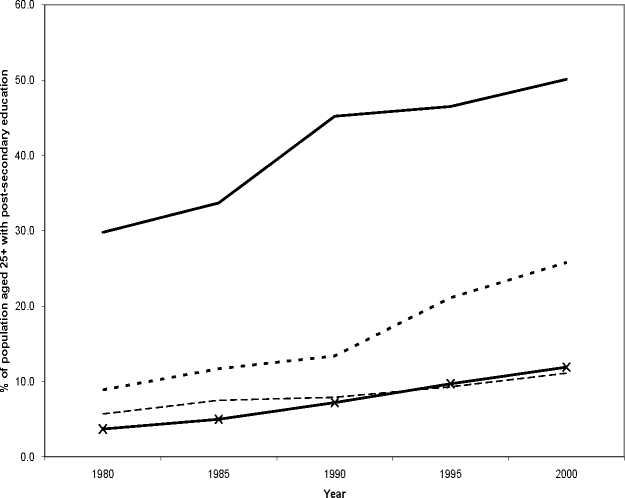tries over the same period.4 More specifically, it shows the proportion of the
population aged over 25 with post-secondary education. We observe that
the countries with the highest post-secondary education attainment levels
are those with exports dominated by high-tech products. In particular, we
notice that while in the beginning of the 1980s Korea’ s attainment level
was close to that of Argentina’s and Poland’s by the end of the 1990s it had
reached considerably higher levels.

Figure 2: Educational Attainment
Our aim in this paper is to provide a theoretical understanding of the
conditions under which it is optimal for governments to encourage shifts in
production that will eventually lead to a reversal in their patterns of trade.
A number of recent papers, (Ishikawa, 1996; Grossman and Maggi, 2002;
Grossman, 2004; Bougheas and Riezman, 2007) examine the relationship
between an exogenous distribution of human capital endowments and the
patterns of trade. In this paper, we make the distribution of human capital
4The data comes from Barro and Lee (2001).
More intriguing information
1. NVESTIGATING LEXICAL ACQUISITION PATTERNS: CONTEXT AND COGNITION2. A Unified Model For Developmental Robotics
3. Thresholds for Employment and Unemployment - a Spatial Analysis of German Regional Labour Markets 1992-2000
4. APPLYING BIOSOLIDS: ISSUES FOR VIRGINIA AGRICULTURE
5. Parallel and overlapping Human Immunodeficiency Virus, Hepatitis B and C virus Infections among pregnant women in the Federal Capital Territory, Abuja, Nigeria
6. Trade and Empire, 1700-1870
7. From Communication to Presence: Cognition, Emotions and Culture towards the Ultimate Communicative Experience. Festschrift in honor of Luigi Anolli
8. The quick and the dead: when reaction beats intention
9. Evaluating the Success of the School Commodity Food Program
10. Testing Hypotheses in an I(2) Model with Applications to the Persistent Long Swings in the Dmk/$ Rate